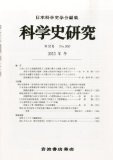中尾麻伊香.「近代化を抱擁する温泉 :大正期のラジウム温泉ブームにおける放射線医学の役割」、『科学史研究』52 (2013): 187-199.
Nakao, Maika “Kindaika o hōyō suru onsen: Taishō-ki no rajium onsen bu-mu ni okeru hōshasen igaku no yakuwari” Kagakushi Kenkyū 52 (2013):187-199
The author of this article is a historian of science specialising in the history of discourses about and representations of science and technology, particularly nuclear power. Her path-breaking work, which examines continuities and discontinues in the portrayals of scientific information about nuclear power in the media, promises useful insight into our post-3:11 situation.
This article focuses on the radium hot spring boom during the Taisho period. As the sudden popularity of radium medicine played a significant role in this boom, the question thus raised is: how did scientific knowledge from the West interplay with traditional Japanese spiritual beliefs about hot springs in this period of modern Japanese history?
Radium was discovered in Japanese hot springs by the medical doctor Manabe Kaichirō and geologist Ishitani Den’ichirō, both of the Tokyo Imperial University. Following their discovery, the medical department of the Japanese army carried out a nation-wide survey of radon-containing hot springs in 1915, which led to the publication of a report charting “radium emanation” levels in mineral springs across the country.
These activities sparked a radium boom, which resulted in the Atami Hot Springs, where radium was first discovered, becoming known as a the first “modern” hot spring resort. Other “modern” spas, including one in Kyobashi, Tokyo, appeared against the backdrop of a prevailing view of radiation medicine as cutting edge science.
As Nakao shows by looking at the case of the Izaka hot spring in Fukushima, however, the connection to radiation medicine was not a straightforward one. She points to a 1927 tourist guide to the Izaka hot springs that attributed the lush plum, pear and plum blossoms enveloping the landscape to the “radium emanation inherent to the Izaka hot spring”. This discourse diverged from strictly medical explanations of the efficacy of radium and went so far as to suggest a “spirit of radium” exerting an influence on the natural surroundings.
The hot spring is thereby interpreted as a ‘contact zone’ where the acceptance of radiation medicine as a modern science was mediated by a variety of factors, including the social and economic considerations of the regions that sought to develop hot springs as tourist destinations. We can see in the Fukushima nuclear power village’s “embrace” of nuclear power through the branding of sushi restaurants (e.g. ‘atom sushi bar’) and confectionary (e.g. ‘nuclear power monaka’), a process similar to how the presence of radium in hot springs was “embraced” during the Taisho period. This historical case study, which reveals how radium has been incorporated into people’s daily lives in prewar Japan, shows how “scientific knowledge is deemed ‘necessary’ according to societal contexts, then accepted and disseminated” These findings will be hugely beneficial in confronting the post-3.11 situation and thus deserve a wide audience.
Original annotation by Kosuke Moriwaki, The University of Tokyo
English translation and condensation of Japanese original: Ruselle Meade, JSPS Postdoctoral Fellow, University of Tokyo
![[Teach311 + COVID-19] Collective](https://blogs.ntu.edu.sg/teach311/files/2020/04/Banner.jpg)
